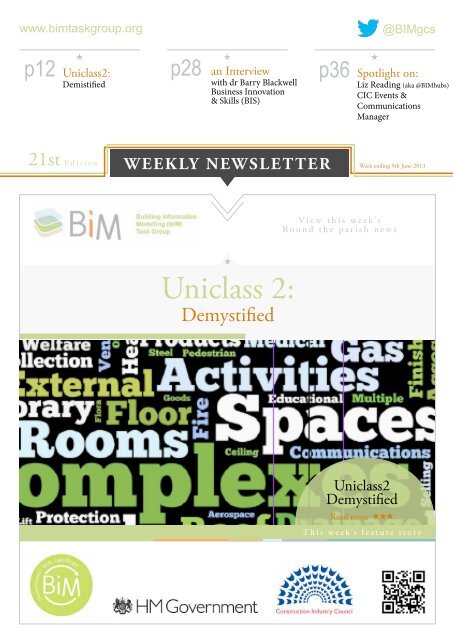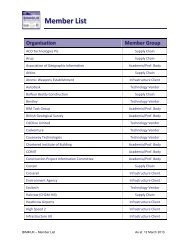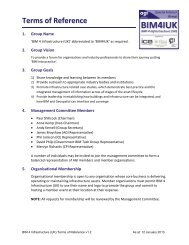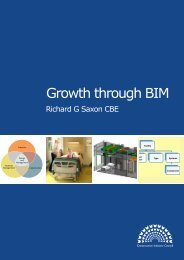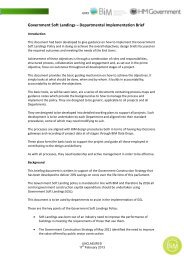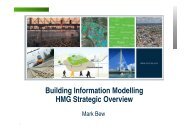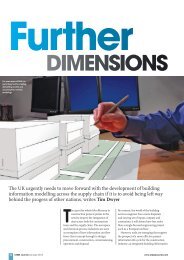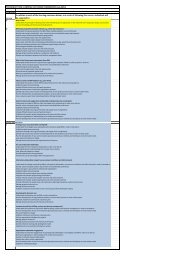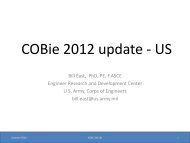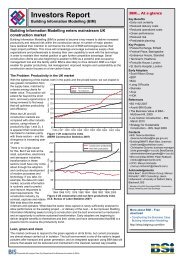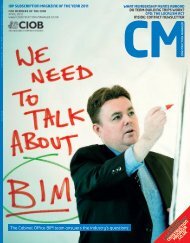BIM Task Group Newsletter 21st Edition
BIM Task Group Newsletter 21st Edition
BIM Task Group Newsletter 21st Edition
You also want an ePaper? Increase the reach of your titles
YUMPU automatically turns print PDFs into web optimized ePapers that Google loves.
www.bimtaskgroup.org<br />
@<strong>BIM</strong>gcs<br />
p12 Uniclass2:<br />
Demistified<br />
p28 an Interview<br />
with dr Barry Blackwell<br />
Business Innovation<br />
& Skills (BIS)<br />
p36 Spotlight on:<br />
Liz Reading (aka @<strong>BIM</strong>hubs)<br />
CIC Events &<br />
Communications<br />
Manager<br />
<strong>21st</strong> <strong>Edition</strong><br />
WEEKLY NEWSLETTER Week ending 9th June 2013<br />
View this week’s<br />
Round the parish news<br />
Uniclass 2:<br />
Demystified<br />
Uniclass2<br />
Demystified<br />
Read more<br />
This week’s feature story
www.bimtaskgroup.org<br />
<strong>Newsletter</strong>, 20th edition | Week ending 2nd June 2013<br />
DEPARTMENTAL ENGAGEMENT AND SUPPORT OFFICER ACTIVITIES (1)<br />
(Department of Health)<br />
ProCure21+ (P21+)<br />
Training Development<br />
• Howard Jeffrey met with the Principal Supply Chain<br />
Partner (PSCP) and Trust at Midlands hospital project to<br />
benchmark <strong>BIM</strong> and review their Plain Language Questions.<br />
It was agreed with the Trust and PSCP to designate<br />
as an early adopter project (EAP) in the area of FM<br />
engagement with the <strong>BIM</strong> process.<br />
{ Philip Isgar }<br />
{ Adam Matthews }<br />
• Adam Matthews and Richard Lane<br />
presented the <strong>BIM</strong> <strong>Task</strong> <strong>Group</strong><br />
Training Strategy to the UKCG<br />
Training <strong>Group</strong><br />
• Adam Matthews updated think-<br />
<strong>BIM</strong> on the Training strategy<br />
• Howard met with a second PSCP at another Midlands<br />
hospital project to benchmark <strong>BIM</strong> and review PLQ’s.<br />
Agreed with PSCP to designate as EAP in the area<br />
of supply chain engagement with the <strong>BIM</strong> process.<br />
Defence Infrastructure<br />
Organisation (DIO)<br />
Preparation for the next project meeting<br />
with DIO’s <strong>BIM</strong> Lead.<br />
{ Richard Lane } { Anne Kemp }<br />
Departmental Engagement<br />
and Support Officers<br />
{ John Lorimer }<br />
{ Graeme Tappenden }<br />
{ Nick Shaw }<br />
Local Government<br />
- Graeme visited iESE Local Government<br />
Procurement Hub <strong>BIM</strong> SIG in<br />
Winchester who work with a large number<br />
of Local Authorities across the southern<br />
half of England. iESE are looking<br />
to include <strong>BIM</strong> in their processes and<br />
contractor framework and are considering<br />
on specific current projects. Both major<br />
contractors present are active with <strong>BIM</strong>.<br />
3
www.bimtaskgroup.org<br />
<strong>Newsletter</strong>, 20th edition | Week ending 2nd June 2013<br />
DEPARTMENTAL ENGAGEMENT AND SUPPORT OFFICER ACTIVITIES (2)<br />
Nuclear<br />
Environment Agency<br />
- Philip met with members of the Nuclear<br />
Industry Council and the forming Client <strong>Group</strong>.<br />
Met with Nuclear Skills Academy and has planned<br />
meetings with NDA Estate - Magnox Sites Sellafield<br />
Ltd and the newly forming <strong>BIM</strong>4Nuclear<br />
Working <strong>Group</strong> (Philip will Chair and be hosted<br />
by National Nuclear Laboratories).<br />
{ Philip Isgar }<br />
{ Adam Matthews }<br />
• Anne met with the EA <strong>BIM</strong> Management<br />
Team to plan the programme and clarify<br />
objectives. Two early adopters are now<br />
identified. Agreed to set up <strong>BIM</strong> Working<br />
<strong>Group</strong> with key reps from the Agency and<br />
its supply chain, similar to that for HA.<br />
{ Richard Lane } { Anne Kemp }<br />
Departmental Engagement<br />
and Support Officers<br />
Highways Agency (HA)<br />
• A successful workshop with key reps from<br />
the proposed early adopters went ahead<br />
this week. We have been developing a<br />
framework to support the Accelerated<br />
Delivery Programme - good progress<br />
on this. The outcome of this particular<br />
workshop were the <strong>BIM</strong> Deliverable<br />
Questions at key points in the process.<br />
{ John Lorimer }<br />
{ Graeme Tappenden }<br />
{ Nick Shaw }<br />
5
www.bimtaskgroup.org<br />
<strong>Newsletter</strong>, 20th edition | Week ending 2nd June 2013<br />
CORE TEAM MEMBER ACTIVITIES (1)<br />
Mark Bew<br />
<strong>Task</strong> <strong>Group</strong> – Chair<br />
Adam Matthews<br />
Departmental Delivery Lead<br />
• HS2 workshop preparation with Bill Grose and<br />
Jon Kirby<br />
• <strong>BIM</strong> Core Team meeting, discussed the programme,<br />
offering more reports to use with<br />
COBie and early Adopter progress<br />
• The Cookham wood savings were confirmed<br />
and will be announced at the Construction<br />
Summit in July…..”They are worth the wait”!<br />
• Attended a social outcomes design and delivery<br />
workshop at Arup<br />
• COBie for Infrastructure planning workshop<br />
• Various department preparation meetings including;<br />
HS2, HA and Local Government<br />
• EU <strong>BIM</strong> Conference planning with BIS and European<br />
stakeholders<br />
• think<strong>BIM</strong> discussion on the <strong>BIM</strong> <strong>Task</strong> <strong>Group</strong> training<br />
strategy and plan<br />
• UKCG Training Working <strong>Group</strong> meeting with Richard<br />
Lane<br />
• Internal <strong>BIM</strong> Core team presentation on updated Training<br />
Strategy and Delivery Team’s departmental engagement<br />
process<br />
• Information exchange with Germany’s developing<br />
<strong>BIM</strong> Working group<br />
7
www.bimtaskgroup.org<br />
<strong>Newsletter</strong>, 20th edition | Week ending 2nd June 2013<br />
CORE TEAM MEMBER ACTIVITIES (2)<br />
David Philp<br />
Cabinet Office<br />
<strong>BIM</strong> Regional Hub: Champions<br />
Training Day<br />
Presented at the Tekla Europe <strong>BIM</strong> Conference alongside Professor Arto<br />
Kivinemi. The UK Level 2 <strong>BIM</strong> programme was seen as a respected<br />
international standard and lots of interest from across the various countries<br />
present.<br />
Keynote for The Chartered Institute for IT CMSG Conference - Configuration<br />
Management – Benefiting from Experience.<br />
Visited the Crossrail <strong>BIM</strong> Training Academy – lots of good takeaways,<br />
thanks to the team for their time.<br />
Chaired the <strong>BIM</strong> Regional Hubs, collaboration and training session.<br />
Presentations and Q&As with Roy Evans (GSL) and Simon Rawlinson<br />
(<strong>BIM</strong> Commercial Suite). Thanks to all the Hub Champions for attending<br />
and their continued support and efforts.<br />
Discussion with private sector clients about programme elements and how they<br />
can develop parallel standards for their own projects to give supply chain consistency<br />
of market demand.<br />
Update meeting with Emma Wharton, CO Construction Team.<br />
Planning activities for GCS Summit <strong>BIM</strong>/GSL Knowledge Hub.<br />
Note: Digital Library and <strong>Newsletter</strong> archive added to website<br />
news pages (thanks to Monika, our web designer<br />
and newsletter co-editor).<br />
David & Arto at European <strong>BIM</strong><br />
Conference<br />
Visit to Crossrail Academy<br />
9
www.bimtaskgroup.org<br />
<strong>Newsletter</strong>, 20th edition | Week ending 2nd June 2013<br />
Government Soft Landings (GSL)<br />
Implementation with central<br />
government departments.<br />
We have met twice this week with the team on the BIS early adopter project at the National Measurement<br />
Laboratory (NML) where the team are actively applying the GSL approach. We identified and reviewed the<br />
key themes of GSL with their end users and operators in order to understand their future needs and to identify<br />
their required project outcomes. Subsequent to this they have established a series of stakeholder groups to<br />
understand what they have to be thinking about in terms of project outcomes related to scientific performance<br />
and maintenance. We met with their project team and provided an overview of the GSL implementation tool<br />
and have started to map on to this the aspects of GSL that they are currently undertaking. They will identify<br />
future opportunities to incorporate GSL into the processes of specification, design, reviews and commissioning<br />
/ testing, and performance evaluation.<br />
The NML day that we attended had GSL as a core theme and identified the GSL Champion as a prominent<br />
role. The day was focussed on establishing protocols and outcomes that would be needed for the scientific,<br />
maintenance and other operational stakeholders and has ensured that GSL has started at the heart of the project.<br />
During the week GSL was reviewed with the Environment Agency and they feel that it should be a relatively<br />
uncomplicated process to implement within their project approach. We are going to undertake a GSL mapping<br />
exercise to identify where GSL might not be adopted in their current process.<br />
{ Rob Manning }<br />
Tools associated<br />
with GSL<br />
{ Deborah Rowland }<br />
GSL Events<br />
An awareness workshop was held with the CIC<br />
<strong>BIM</strong> Hub regional representatives where it was<br />
agreed that looking further at GSL from the perspectives<br />
of different stakeholders would be useful<br />
and would support them in getting the message<br />
out across the country. In addition, it was agreed<br />
that CIC <strong>BIM</strong> Hubs are going to try and identify<br />
further examples of GSL from the private sector<br />
and from the wider government perspective to assist<br />
in sharing lessons learned.<br />
A meeting with the Education Funding Agency identified that they are happy to embrace GSL approach and<br />
we are shortly going to meet again to identify the next steps which will include a look at where GSL is not<br />
being adopted and could be implemented further. A key focus will be upon how to reflect the needs and skills<br />
development of the people who maintain and operate schools.<br />
The MoJ are now undertaking POE on a regular basis and have forwarded a further POE study to us; we will<br />
look to these as case studies so that we make sure that this knowledge is taken across into other departments<br />
through the means of the GSL Stewardship <strong>Group</strong>.<br />
Thanks to those who have responded to nominate representatives on the GSL Stewardship <strong>Group</strong> –<br />
we still need to hear from a few remaining departments about who their GSL lead is going to be.<br />
If you are a representative of the Government Construction Board or the Facilities Management<br />
Board and have not yet been in contact then please do so .<br />
Work on PAS 1192 Part 3 is expected to start next<br />
week.<br />
We met with a software company who are interested to<br />
develop their application further in support of the GSL<br />
approach. Currently they are providing their services<br />
on education and defence projects.<br />
Attended a CarbonBuzz event that publicised a free<br />
resource which allows anyone to share building energy<br />
use data on an anonymous basis and publish projects<br />
to showcase expertise.<br />
{ Roy Evans }<br />
11
www.bimtaskgroup.org<br />
<strong>Newsletter</strong>, <strong>21st</strong> edition | Week ending 9th June 2013<br />
Uniclass 2:<br />
Demystified<br />
Whether you are in the supermarket or searching for information<br />
on Google maps, classification is the key to finding<br />
“what you want<br />
Uniclass2 and Integrated, Interoperable Data<br />
Both the US and UK Governments have,<br />
in recent years, promoted the idea of open,<br />
reusable data to create a culture of collaboration,<br />
sharing and knowledge reuse.<br />
Barack Obama recently mandated an Open<br />
”<br />
by Sarah Delany & Stuart Chalmers<br />
Data Executive Order stating that “government<br />
data shall be made freely available in<br />
open, machine-readable formats” [2], while<br />
the UK Goverment has invested £10m in<br />
the Open Data Institute [3] to promote<br />
a culture of publishing and utilising data<br />
openly for sharing and reuse, as well as releasing<br />
over 9000 government datasets through the data.<br />
gov.uk initiative [4].<br />
The idea to follow these principles and release the<br />
new Uniclass2 system in a such a way began with<br />
the <strong>BIM</strong> Gateway project [5], a joint Technology<br />
Strategy Board funded initiative led by the RIBA<br />
Technical Research Department and Geoffrey<br />
Makstutis at the University of the Arts London,<br />
aiming to deliver a structured, reusable online<br />
Uniclass2 system for the construction industry<br />
that would:<br />
* Be fit for <strong>BIM</strong> level 3 and the aim of “Integrated,<br />
Interoperable Data”.<br />
* Be available in a variety of non-proprietary, reusable<br />
digital formats.<br />
While the original Uniclass was published in 1997<br />
as a hard copy book of tables, the release of Uniclass2<br />
requires a delivery method with the ability<br />
to provide new, well documented releases and<br />
versioned updates as the classification matures, and<br />
to cater for new processes, materials and working<br />
methods brought about by the uptake of <strong>BIM</strong>.<br />
The <strong>BIM</strong> Gateway project has so far produced<br />
structured data versions of the first seven Uniclass2<br />
tables released, available<br />
through a fully<br />
searchable tool and<br />
downloadable in a number click of open > p.16 formats<br />
(though the <strong>BIM</strong> <strong>Task</strong> <strong>Group</strong> labs [6]). Because<br />
of the open structured format of the data, visualisation<br />
tools can also be applied to process and<br />
present the Uniclass2 system in a variety of ways<br />
click > p.18 click > p.20<br />
to help convey the structure and hierarchy inherent<br />
in the classification.<br />
Stuart Chalmers<br />
Stuart Chalmers is <strong>BIM</strong> Technical<br />
Manager at BRE, researching and<br />
developing tools and processes for <strong>BIM</strong><br />
collaboration and certification.<br />
Before joining the BRE, he worked<br />
as a Technical Research Officer at<br />
the Royal Institute of British Architects,<br />
managing and developing <strong>BIM</strong> related<br />
research projects, specifically<br />
inthe representation and use<br />
of construction project information and<br />
collaborative knowledge management.<br />
He is technical advisor to<br />
the Construction Project Information<br />
Committee and sits on the Uniclass2<br />
working group and the BuildingSMART<br />
UKI Technical <strong>Group</strong>.<br />
He previously worked at<br />
the SP Technical Research Institute<br />
of Sweden, contributing to design<br />
communication languages for distributed<br />
driving simulator prototypes and<br />
at the University of Glasgow,<br />
investigating the modelling<br />
and collaborative re-use of astronomy<br />
information as part of<br />
the International Virtual Observatory<br />
Alliance (IVOA) data<br />
representation initiative<br />
13
www.bimtaskgroup.org<br />
<strong>Newsletter</strong>, <strong>21st</strong> edition | Week ending 9th June 2013<br />
The full Uniclass2 tables will cover<br />
the complete project lifecycle.<br />
15
www.bimtaskgroup.org<br />
<strong>Newsletter</strong>, <strong>21st</strong> edition | Week ending 9th June 2013<br />
The current Uniclass2 tables are available<br />
are available as a fully searchable tool on<br />
the <strong>BIM</strong> <strong>Task</strong> <strong>Group</strong> website<br />
17
www.bimtaskgroup.org<br />
<strong>Newsletter</strong>, <strong>21st</strong> edition | Week ending 9th June 2013<br />
As open, structured data, Uniclass2<br />
can be visualised in a number of ways<br />
19
www.bimtaskgroup.org<br />
<strong>Newsletter</strong>, <strong>21st</strong> edition | Week ending 9th June 2013<br />
As open, structured data, Uniclass2<br />
can be visualised in a number of ways<br />
21
www.bimtaskgroup.org<br />
<strong>Newsletter</strong>, <strong>21st</strong> edition | Week ending 9th June 2013<br />
Classification<br />
Whether you are in the supermarket or searching<br />
for information on Google maps, classification<br />
is the key to finding what you want. Classification<br />
should provide a system that allows<br />
information to be found and retrieved easily,<br />
with ‘rules’ that are easy to understand, even<br />
intuitive, and allow information to be added<br />
in a logical manner. It must also be possible to<br />
reference, update, and maintain the information.<br />
Building on the original Uniclass 1997,<br />
Uniclass 2 is the classification system that sets<br />
out to provide this for the construction industry<br />
in the <strong>BIM</strong> age.<br />
The basis for Uniclass 2 is the international<br />
standard ISO 12006-2 which sets out the<br />
issues very clearly:<br />
Modern information systems for the construction<br />
industry, whether local or networked,<br />
need to handle data of many different types,<br />
e.g. geometrical data, technical properties, cost<br />
data, maintenance data, for use within different<br />
applications such as CAD, specification,<br />
product information and cost information<br />
systems. All these data and the relations between<br />
them need to be defined and structured<br />
in such a way that the stored information is<br />
consistent and reliable within and between the<br />
different applications.<br />
So the principles are clear but the implementation<br />
is often not so evident, especially when<br />
using a national standard rather than a practice<br />
specific method. Anyone who has used either<br />
NBS or NES specification tools will have used<br />
the Common Arrangement of Work Sections<br />
(CAWS) which is one of the tables from Uniclass<br />
1997. However the classification is buried<br />
in the software so there is no need to understand<br />
it.<br />
People creating graphical (3D modelled) information<br />
found the elements table, G, more<br />
appropriate for their needs and Librarians and<br />
Manufacturers have used the products table,<br />
L, extensively but the problem with the tables<br />
in Uniclass 1997 is that it is not easy to link<br />
from one table to another. Linking graphical<br />
information to specification, for example,<br />
could not be done in the original Uniclass. So<br />
CPIc (the Construction Projects Information<br />
committee) has set about resolving this situation<br />
in order to provide a classification for<br />
use by anyone in the construction industry<br />
throughout the lifecycle of a project by producing<br />
and publishing proposals for Uniclass<br />
2.<br />
Uniclass 2 objectives<br />
• To produce a classification system for structuring<br />
information that is freely available for<br />
all participants throughout the life cycle of a<br />
project and beyond<br />
• Endorsed by all construction and property<br />
bodies and professional institutions<br />
• To be dynamic, available in a variety of<br />
interoperable formats<br />
• Managed by a team of experts who will<br />
monitor requests, update and control versioning.<br />
The Scope of Uniclass 2 covers architecture<br />
(buildings and landscape), and civil and<br />
process engineering; the terminology will be<br />
the same from table to table; and the tables<br />
will link logically. Coding will generally be in<br />
four and sometimes five levels, ranging from<br />
table reference, through <strong>Group</strong> and Sub-group<br />
to object. The coding below level 1 will be<br />
numeric with alpha characters to identify the<br />
table content.<br />
The full list of tables to be developed is:<br />
Management tables<br />
FI – Form of Information<br />
Style of presentation, basic nature or<br />
status and type of medium.<br />
SD – Subject Discipline<br />
Body of knowledge of a profession or<br />
field of knowledge.<br />
Mn – Management<br />
Processes for planning, administrating<br />
or assessing operations specific to the<br />
construction industry and its agents.<br />
PP – Project Phases<br />
A table giving a framework for infor<br />
mation throughout the stages defined<br />
in the CIC work stages.<br />
Zz – CAD<br />
Life cycle tables<br />
Re -<br />
Di -<br />
Co –<br />
Ac –<br />
Sp –<br />
En –<br />
Regions<br />
A collection of related districts and<br />
their infrastructure networks.<br />
Districts<br />
A collection of related complexes<br />
and their infrastructure networks.<br />
Complexes<br />
One or more adjacent entities<br />
collectively serving one or more<br />
activity.<br />
Activities<br />
Function carried out in a space or<br />
of spaces. Some spaces may be used for<br />
a number of activities either simultane<br />
ously or consecutively.<br />
Spaces<br />
Location contained within, or oth<br />
erwise associated with, a building or<br />
other construction entity<br />
Entities<br />
Independent construction result of sig<br />
Ee –<br />
Ss –<br />
Pr –<br />
nificant scale. Entities can contain one<br />
or more spaces for one or more activi<br />
ties in a complex.<br />
Elements<br />
Part of an entity which, in itself or in<br />
combination with other such<br />
parts, forms an entity<br />
Systems<br />
Built objects made up of several prod<br />
ucts, collectively serving a common<br />
purpose, often a single trade.<br />
Products<br />
Material construction resource intend<br />
ed for incorporation in a permanent<br />
manner in a construction entity<br />
Ml – Materials<br />
Substances and materials from which<br />
products, elements and entities<br />
can be made.<br />
PC –<br />
Properties and Characteristics<br />
Performance factors associated with<br />
complexes, spaces, entities, elements,<br />
systems and products.<br />
CA – Construction Aids<br />
Material resources used in production,<br />
maintenance and demolition activities,<br />
but not intended for<br />
incorporation in construction entities.<br />
Linking tables<br />
WR – Work Results<br />
Construction result achieved in the<br />
production stage or by subse<br />
quent alteration, maintenance or<br />
demolition processes<br />
WS – Work Results Substructure<br />
Sets out a framework for all informa<br />
tion in the Work results table to give a<br />
consistent approach.<br />
23
www.bimtaskgroup.org<br />
<strong>Newsletter</strong>, <strong>21st</strong> edition | Week ending 9th June 2013<br />
Current Work<br />
Members of CPI and its sponsors are preparing<br />
some Use cases to illustrate how the tables can<br />
be used, both on buildings and infrastructure<br />
projects.<br />
NBS has used the Work Results table for NBS<br />
Create – the new specification package – and<br />
this has provided a valuable test for how the<br />
coding works.<br />
A revised version of the Products table is being<br />
prepared following feedback on the proposal<br />
on the website.<br />
So it’s time to get involved and ensure that the<br />
UK has a fully operational and useable classification<br />
for <strong>BIM</strong>.<br />
If you want to be involved or have any ideas or<br />
comments, then please contact:<br />
Sarah Delany (sarah@cpic.org.uk)<br />
For further information browse the following<br />
websites:<br />
• CPI (www.cpic.org.uk)<br />
• <strong>BIM</strong> Gateway (www.bimgateway.co.uk)<br />
• NBS (www.thenbs.com)<br />
Where we are now and how you can help<br />
Some of the tables are ready to be used now and feedback from that use will help to illustrate where<br />
things are missing and what is not easy to understand.<br />
The tables available in beta format on<br />
the <strong>BIM</strong> <strong>Task</strong> <strong>Group</strong> website are:<br />
Tables available for comment on<br />
the CPI website are:<br />
p<br />
The tables develop through a logical hierarchy such that large objects or ‘complexes’ are made up of a<br />
number of ‘entities’ such as buildings, roads, car parks, bridges, etc.; and will accommodate a number<br />
of different ‘activities’.<br />
An ‘entity’ can be defined by ‘activities’ carried out, the ‘spaces’ contained and ‘elements’.<br />
Elements are walls, roofs, pavements, ventilation systems and these are made up of ‘systems’ which<br />
comprise ‘products’.<br />
These table titles are specific to the definitions in ISO 12006-2 in most cases but the terms may be<br />
used in different ways by different organisations. CPI is developing a list of synonyms to help to clarify<br />
what tables are appropriate in what circumstances and you can assist with this.<br />
The Uniclass working group meet<br />
regularly to discuss and develop new<br />
Uniclass2 tables, and to take<br />
on board comments and suggestions<br />
from industry<br />
23
www.bimtaskgroup.org<br />
<strong>Newsletter</strong>, <strong>21st</strong> edition | Week ending 9th June 2013<br />
Each table has groups of similar information and follows a hierarchy that expands with increasing<br />
levels of granulation from a two digit code to six digits. For example, in the Administrative and<br />
Commercial group of the entities table Commercial Administrative Buildings are classified as 25-50<br />
with small single office buildings having a lower level classification of 25-50-70. This principle of<br />
increasing granulation applies to all tables.<br />
Activities<br />
Using the tables<br />
Complexes<br />
Entities<br />
Activities Spaces Elements<br />
Systems<br />
Products<br />
There are no hard and fast rules about what is right, so choosing the appropriate table is subjective.<br />
The following are all possibilities for classifying a prison leaving the choice of the most appropriate to<br />
the users but with some consensus sought across the project team.<br />
Co_25_85 Detention complexes<br />
Co_25_85_10 International detention co<br />
plexes<br />
Co_25_85_30 National detention complexes<br />
Co_25_85_50 Regional detention complexes<br />
Co_25_85_70 Local detention complexes<br />
Ac_25_85 Detention activities<br />
Ac_25_85_15 Communal inmate day activities<br />
Ac_25_85_22 Detaining<br />
Ac_25_85_28 Exercising<br />
Ac_25_85_35 Guarding detainees<br />
Ac_25_85_38 Holding<br />
Ac_25_85_59 Open secure visiting<br />
Ac_25_85_66 Private secure visiting<br />
Ac_25_85_95 Vehicle impounding<br />
En_25_85 Detention entities<br />
En_25_85_10 International detention builings<br />
En_25_85_12 International detention<br />
grounds<br />
En_25_85_30 National detention buildings<br />
En_25_85_32 National detention grounds<br />
En_25_85_50 Regional detention buildings<br />
En_25_85_52 Regional detention grounds<br />
En_25_85_70 Local detention buildings<br />
En_25_85_72 Local detention grounds<br />
Sp_25_85 Detention spaces<br />
Sp_25_85_15 Communal inmate dayrooms<br />
Sp_25_85_22 Detention cells<br />
Sp_25_85_28 Exercise yards<br />
Sp_25_85_35 Guard stations<br />
Sp_25_85_38 Holding cells<br />
Sp_25_85_59 Open secure visiting rooms<br />
Sp_25_85_66 Private secure visiting rooms<br />
Sp_25_85_95 Vehicle impound yards<br />
Terminology is another issue, so that words<br />
that we use and understand among ourselves<br />
may not be as clear to others. The language<br />
in classification therefore has to be generic<br />
but project specific information can use more<br />
familiar language.<br />
For example, a prison is described generically<br />
as a Detention complex or a Detention Activity.<br />
Although the classification uses a generic<br />
term, the project specific term can still be<br />
Holloway Prison and the description can either<br />
be of a complex or an activity – both are valid<br />
but a client may have a preference for which is<br />
most appropriate.<br />
Another example is that ‘station’ can be used<br />
to describe a place for catching a train or bus,<br />
but it is also used to describe a ‘fire station’ and<br />
a ‘work station’. So the classification has to be<br />
generic so that it is clear what is being coded.<br />
A station is an embarkation and disembarkation<br />
complex generically but will be known as<br />
a station as far as the project is concerned.<br />
23
www.bimtaskgroup.org<br />
<strong>Newsletter</strong>, <strong>21st</strong> edition | Week ending 9th June 2013<br />
Future Updates<br />
Further Uniclass2 developments in the coming<br />
months include additional tables covering<br />
products, project phases, CAD and work results<br />
substructure, and a full repository containing versioned,<br />
downloadable Uniclass2 releases.<br />
Currently Uniclass2 contains 7 complete<br />
tables, with further tables being released<br />
in the coming months<br />
Sarah Delany<br />
Sarah is a technical author<br />
at NBS with responsibility for<br />
the mechanical services sections<br />
in the NBS products.<br />
She joined NBS in 2002<br />
and worked on the first launch<br />
of NBS Engineering Services.<br />
Sarah is also secretary<br />
of the CPI committee and is involved<br />
with the current projects<br />
for unifying Uniclass and updating<br />
the CPIx protocol.<br />
Having graduated from<br />
Loughborough University,<br />
Sarah started her career as<br />
a contractor with Rosser and Russell followed<br />
by a period at<br />
R W Gregory and Partners.<br />
In 1985 Sarah became editor<br />
of NES when it was owned<br />
by CIBSE and took over as manager<br />
in the 1990’s.<br />
For updates on further Uniclass2 developments,<br />
and other Uniclass2 news follow @CPICommittee<br />
on twitter.<br />
web reference<br />
Uniclass2 will be available to download<br />
from a fully versioned repository<br />
in a variety of open formats<br />
[1] https://www.gov.uk/government/news/publicdata-means-the-uk-is-open-for-business<br />
[2] http://www.whitehouse.gov/the-press-office/2013/05/09/obama-administration-releases-historic-open-data-rules-enhance-governmen<br />
[3] http://www.theodi.org/<br />
[4] http://data.gov.uk/about-us<br />
[5] http://www.bimgateway.co.uk/<br />
26/09/2012<br />
Glasgow<br />
[6] http://www.bimtaskgroup.org/uniclass2/<br />
23
“ ”<br />
The <strong>BIM</strong> ‘genie’ is well<br />
and truly out of the bottle<br />
www.bimtaskgroup.org<br />
<strong>Newsletter</strong>, <strong>21st</strong> edition | Week ending 9th June 2013<br />
an Interview<br />
with<br />
dr Barry<br />
Blackwell<br />
Business<br />
Innovation<br />
& Skills (BIS)<br />
29
www.bimtaskgroup.org<br />
<strong>Newsletter</strong>, <strong>21st</strong> edition | Week ending 9th June 2013<br />
<strong>BIM</strong>: PEOPLE MATTERS<br />
14 QUESTIONS WITH<br />
DR BARRY BLACKWELL<br />
BUSINESS INNOVATION<br />
Q& SKILLS (BIS)<br />
This week we interview Barry Blackwell who is<br />
the BIS Policy Lead for exploitation of <strong>BIM</strong> and<br />
Programme Manager for the Government Grant<br />
Programme. He is also a Member of the <strong>BIM</strong><br />
Programme Steering <strong>Group</strong> and is developing UK<br />
strategic development of <strong>BIM</strong> with the <strong>BIM</strong> <strong>Group</strong>.<br />
Barry a founding member of the <strong>BIM</strong> team shares<br />
his thoughts on <strong>BIM</strong> and his passion for time-pieces.<br />
1 2<br />
Hi Barry, can you tell us a little about your<br />
background?<br />
I am a Geologist by background, worked in the<br />
North Sea, returned to Uni, and then started<br />
as a Chartered accountant for a year in private<br />
practice before getting a good offer from a then<br />
Government Research Establishment to undertake<br />
research into the mineralogy of aggregates.<br />
I transferred to central government as part of<br />
the M4I programme in 2000 and then into<br />
policy positions.<br />
What is BIS’ current role with the UK Government<br />
<strong>BIM</strong> roll out?<br />
I lead for BIS on <strong>BIM</strong>, work closely with<br />
Cabinet Office on the programme and manage<br />
the BIS’s Grant programme with Construction<br />
Industry Council. My main interest now that<br />
the programme is in train is about the growth<br />
potential of <strong>BIM</strong>, EU engagement and paving<br />
the way for the next iteration of <strong>BIM</strong> (thought<br />
Digital Built Britain). But I should make<br />
it clear that the views I express here are not<br />
necessarily those of the Department but solely<br />
mine and made as a member of the <strong>BIM</strong> <strong>Task</strong><br />
<strong>Group</strong>. For the avoidance of any doubt, I am<br />
in no shape or form a <strong>BIM</strong> expert.<br />
31
www.bimtaskgroup.org<br />
<strong>Newsletter</strong>, <strong>21st</strong> edition | Week ending 9th June 2013<br />
3 4 5<br />
Where you immediately converted to <strong>BIM</strong>.<br />
Actually, no. Some people ‘get it’ first time<br />
but when I first heard of <strong>BIM</strong> (If I recall correctly<br />
from a NESTA report) I was very sceptical<br />
and resistant. However, I have a passionate<br />
interest in (strategic) Lean construction<br />
and Design for Manufacturer and Assembly<br />
(DfMA) and I had a ‘Eureka’ moment on the<br />
connectivity of the ideas and I have not looked<br />
back. There is no shame in being a doubter -<br />
the only shame is false pride stopping a person<br />
from altering their view in light of emerging<br />
evidence. I think many people will start by<br />
being sceptical and, should I be any yardstick<br />
to go by, they will need time to rationalise <strong>BIM</strong><br />
to their own vision and model of good quality<br />
construction delivery (this period of adjustment<br />
is necessary and one reason why we provided<br />
a four-year lead-in to to the programme) the<br />
important thing then is to act decisively.<br />
How did BIS get involved with the <strong>BIM</strong><br />
programme?<br />
Looking back from what has been achieved to<br />
date and taking into account the fact it is only<br />
comparatively recently that <strong>BIM</strong> has become<br />
part of the lexicon for most people, it is difficult<br />
to believe that the idea of a <strong>BIM</strong> implementation<br />
strategy was hatched out over a conversation<br />
with Mark Bew and colleagues back<br />
2009. Then, as now, BIS encourages officials<br />
to follow their instincts on new ideas and I<br />
agreed with Mark to establish a working group<br />
to devise a strategy within 6 months to inform<br />
the Government Construction Board. Not<br />
knowing what the result would be, my boss<br />
here agreed to ‘carve-out’ a bit of time from<br />
the programme to allow the work to progress<br />
- in what, surely, must be counted as one of<br />
the pivotal decisions in UK <strong>BIM</strong>. This work<br />
turned into what is widely termed the ‘BIS<br />
<strong>BIM</strong> Strategy’ and then adopted by the Government’s<br />
Construction Strategy and the now<br />
familiar joint Cabinet Office/BIS programme.<br />
Why has the programme be successful?<br />
Firstly the people, The <strong>BIM</strong>-team are fantastic<br />
and a true exemplar of how the Civil<br />
Service and Industry can work together as a<br />
single team. I have the greatest respect for the<br />
talent, vision and leadership of Mark and Paul<br />
Morrell (who have done so much) and to the<br />
Construction Industry Council. But lets just<br />
give a bit of nod to the Civil Servants/public<br />
officials across government who quietly have<br />
‘done their bit’.<br />
Secondly it is a sound strategy, which requires<br />
clients to clearly set out their data requirements<br />
whilst leaving the industry to respond commercially<br />
(and in being non-proprietary in terms<br />
of <strong>BIM</strong> tools).<br />
Thirdly, over the last few years there has been<br />
a growing desire within industry (and the<br />
client base) to accelerate change away from<br />
the ‘old ways’ - <strong>BIM</strong> was in the right place at<br />
the right time. In this and many other ways<br />
I recognise we have had been fortunate - we<br />
grabbed the fortune given to us and used it to<br />
the advantage of the <strong>BIM</strong> project. The team’s<br />
motto was ‘keep going’ forward.<br />
6<br />
How is important do you think <strong>BIM</strong> is to the<br />
future of the UK construction sector?<br />
<strong>BIM</strong> (in it widest definition of tools, process<br />
and culture) is a big part of the change agenda<br />
for the industry (and their clients) but it has to<br />
be set within an overarching approach to construction<br />
which brings in other ideas - including<br />
‘lean’ thinking and improved procurement.<br />
It almost goes without saying that it has to be<br />
used ‘intelligently and knowledgably’. It also<br />
about clients and industry working as a team<br />
and I would like to say that there is no ‘I’ in<br />
<strong>BIM</strong> ...but alas.<br />
33
www.bimtaskgroup.org<br />
<strong>Newsletter</strong>, <strong>21st</strong> edition | Week ending 9th June 2013<br />
7 8 9<br />
As<br />
It is often stated that the UK approach to<br />
<strong>BIM</strong> puts us number 1 in the global league<br />
table. Do you think this is the case ?<br />
Does it matter? but what we can say is our<br />
programme is much commented on around the<br />
world and our approach is improving the image<br />
of the construction sector both domestically<br />
and internationally and anecdotal evidence suggests<br />
we are ‘winning work’ on the back of it.<br />
Importantly, major software supplier are also<br />
investing time and effort in the UK and there is<br />
growing confidence for our own<br />
software industry.<br />
What do you think is the next big milestone<br />
in the <strong>BIM</strong> programme?<br />
<strong>BIM</strong> (in the widest definition) is a portal to a<br />
‘new world’ and in common with all new ideas<br />
or inventions (say graphene) we are only just<br />
beginning to understand its potential. ‘Good’<br />
Data supplied, information gleaned, and quality<br />
decision taken, will pave the way for better<br />
design, construct and operation of assets on a<br />
project, programme and portfolio scale (how<br />
more efficiently could the management of the<br />
entire estates be with the use of <strong>BIM</strong> information?).<br />
I am also interested in data/information<br />
flows within the wider built environment<br />
and how <strong>BIM</strong> connects. On a more immediate<br />
scale I think <strong>BIM</strong>-enabled ‘Lean construction’<br />
with DFMA (and offsite) will now really<br />
come into shape focus.<br />
Looking forward how important is it for the<br />
UK to lead on Level 3 <strong>BIM</strong> maturity?<br />
The <strong>BIM</strong> ‘genie’ is well and truly out of the<br />
bottle and innovation will be relatively swift<br />
with this new technology - there will be many<br />
new opportunities for construction and software<br />
companies. To stand still will be to go<br />
backwards as other countries ‘leap-frog’ - but<br />
why would this be important? <strong>BIM</strong> is global<br />
and construction is becoming increasingly<br />
global and, by degrees, eroding away any<br />
domestic insulation from global competitors<br />
. We are in a good position to cement UK<br />
presence in developing common <strong>BIM</strong> standard,<br />
protocols and processes - which surely would<br />
be good for the UK and potentially a source of<br />
competitive advantage.<br />
10<br />
a long serving civil servant what has been<br />
your most memorable career moment?<br />
Investigating the micro-structure and mineralogy<br />
of UK greywacke deposits to better<br />
understand their alkali-reactivity and which<br />
ultimately led to a new technical standard. I<br />
worked with a great team (never to be reassembled)<br />
which included internationally respected<br />
scientists. I vividly remember the period as<br />
the mantle of project and scientific leadership<br />
passed from the hands of the older generation<br />
to my generation - I was no longer the ‘young<br />
scientist’ and took the opportunity. I don’t<br />
doubt there is someone in the <strong>BIM</strong>2050 who<br />
will shortly experience the same - <strong>BIM</strong> will, if<br />
not already, be theirs to take forward -grasp the<br />
opportunity and I wish you well.<br />
35
www.bimtaskgroup.org<br />
<strong>Newsletter</strong>, <strong>21st</strong> edition | Week ending 9th June 2013<br />
11<br />
There must have been some funny stories!<br />
Any you can share?<br />
My trouble is that I tend to laugh in all the<br />
wrong places ... it gets me into trouble<br />
13<br />
12<br />
So for someone so switched onto digital<br />
construction why are you so interested in<br />
analogue clocks and watches?<br />
On one level precision mechanical watch/clock<br />
manufacture is ‘advanced manufacturing’ and<br />
I suspect been using sophisticated software<br />
for ‘donkey years’. Even mechanical watchmakers<br />
continually innovate in design and<br />
utilise modern high-grade ceramic materials<br />
We understand you are a fan of mechanical<br />
time pieces .<br />
Yes, I have two main hobbies - medal collecting<br />
to the Great War (and hence my often<br />
cited date of <strong>21st</strong> March 1918 in connection<br />
with the strategy) and I am a member of the<br />
OMRS. As you correctly say, I am doing my<br />
examinations for the British Horological Institute<br />
- in fact, badly, as the BHI have amazing<br />
craft persons as exam markers - they don’t<br />
dumb-down, they don’t pass second best and<br />
they are not driven by ‘pass’ statistics (as I am<br />
shortly to find out) - long may that live.<br />
and, of course, they aim to produce something<br />
which works accurately first time - not unlike<br />
construction. Software tools do have many<br />
‘mind-blowing’ attributes but can it match the<br />
feeling of handling a well-crafted mechanical<br />
object? I love handling something built by<br />
people long ago, sharing the same experience<br />
of generations of craft persons in dismantling/<br />
repairing the object (and probably use the<br />
same descriptive language) and the intense<br />
concentration and ‘nerves’ of replacing parts of<br />
no greater that a couple of millimetres knowing<br />
they could ‘ping’ if you get it wrong ( I recommend<br />
everyone have a go ) In short, its like<br />
the construction industry it is about talented<br />
people - constructing incedible structures.<br />
14<br />
Tell us something about yourself we would<br />
not know.<br />
I am a member of MCIPS.<br />
37
www.bimtaskgroup.org<br />
<strong>Newsletter</strong>, <strong>21st</strong> edition | Week ending 9th June 2013<br />
Regional <strong>BIM</strong><br />
Hubs: The Untold<br />
Story…<br />
The Regional Hubs help raise awareness and benefits<br />
of <strong>BIM</strong>; help facilitate the early adoption of <strong>BIM</strong><br />
processes and working methods throughout the UK’s<br />
construction industry. The Hubs also provide an<br />
“important feedback mechanism into the <strong>Task</strong> <strong>Group</strong>.<br />
In March 2012 at a<br />
meeting of the Chairs<br />
of CIC’s regional<br />
committees, BIS and the <strong>BIM</strong> <strong>Task</strong><br />
<strong>Group</strong> tasked us with creating the <strong>BIM</strong><br />
Regional Hubs. CIC has had network<br />
of regional committees across the UK<br />
for some ten plus years now and I have<br />
been managing them for nearly five so<br />
it seemed only natural that we would<br />
align these new hubs with our current<br />
arrangement. Our regional committees<br />
already provide an influential, collecby<br />
Liz Reading<br />
”<br />
tive voice for the Built Environment; consider<br />
issues relevant to their region and to promote<br />
public awareness of the construction industry.<br />
The regions had already become aware of<br />
Building Information Modelling and its<br />
importance to the industry. They believed<br />
<strong>BIM</strong> information and guidance should be<br />
offered on a local level under the CIC umbrella<br />
encompassing the industry as a whole and<br />
welcomed the suggestion of the Hubs. The<br />
Regional Hubs would help raise<br />
awareness and the benefits of<br />
<strong>BIM</strong> and help facilitate<br />
the early adoption<br />
of <strong>BIM</strong> processes<br />
and<br />
working<br />
methods<br />
throughout the UK’s construction industry.<br />
The Hubs would also provide an important<br />
feedback mechanism into the Government.<br />
Each Hub would be headed up by a <strong>BIM</strong><br />
Champion who would be a <strong>BIM</strong> font of<br />
knowledge for their region, supported by a<br />
member of the task group.<br />
The <strong>BIM</strong> Hubs Objectives were set as:<br />
<strong>BIM</strong> Hubs Objectives<br />
• Interface with the core team and the emerging legacy<br />
support organisation to raise awareness of the<br />
<strong>BIM</strong> programme and its requirements<br />
• Act as a conduit for relevant information on the<br />
programme to ensure a consistent and contextualised<br />
message is disseminated<br />
• Enable regional engagement in national discussions<br />
• Encourage the sharing of <strong>BIM</strong> knowledge and best<br />
practice within the networks<br />
• Facilitate regional collaborative activity to support<br />
the development of the supply chain’s <strong>BIM</strong> capabilities<br />
• Provide linkage with the GCS <strong>BIM</strong> <strong>Task</strong> <strong>Group</strong> and<br />
the CIC <strong>BIM</strong> Forum<br />
• Provide valuable feedback to the core team<br />
37
www.bimtaskgroup.org<br />
<strong>Newsletter</strong>, <strong>21st</strong> edition | Week ending 9th June 2013<br />
To help kick start the hubs we decided to run a<br />
series of events across the UK which would act<br />
as an launch for the Hubs as well as seminar<br />
introducing practitioners to <strong>BIM</strong>. The event<br />
series, ‘A <strong>BIM</strong> Focus’, was developed featuring<br />
task group members talks and local case<br />
studies. It became the most retweeted tweet @<br />
CICTweet (how about that for a tongue twister)<br />
had ever sent which paved the way for the<br />
Hubs having their own social media platform<br />
@<strong>BIM</strong>Hubs.<br />
In my infinite wisdom, and because I already<br />
had a weeks holiday booked in October, it was<br />
decided that these 17 events would run over<br />
the course of six weeks in the autumn of 2012.<br />
We referred to these events as <strong>BIM</strong> on tour<br />
and likened ourselves to rock stars, although<br />
no one threw a TV out of a hotel window.<br />
The first event took place on September 25th<br />
in Newcastle and despite nearly not making<br />
the event due to torrential rains and flooded<br />
rail lines, which unfortunately also deterred<br />
a few of attendees, it was still a very positive<br />
first event. After a soggy start in Newcastle<br />
we went onwards to Edinburgh and Glasgow<br />
for our two Scottish events, then the following<br />
week Wrexham and Manchester. After my trip<br />
away we carried on with Cambridge, Coventry,<br />
Nottingham, Exeter, Bristol, Cardiff, Leeds,<br />
Hull, London (x2), Northampton and finally<br />
Belfast. With over 1500 people registered<br />
to attend the <strong>BIM</strong> Focus events we aimed to<br />
equip them with basic <strong>BIM</strong> knowledge, some<br />
real life <strong>BIM</strong> stories and provided plenty of<br />
opportunity for questions, no matter how silly<br />
delegates may have deemed them, to be asked.<br />
Highlights from the Hub events include a<br />
missing <strong>Task</strong> <strong>Group</strong> Member in Cambridge<br />
and having to play a video of David Philp instead,<br />
(virtual Philpster) listening to some great<br />
case studies from across the UK including a<br />
rather refreshing one which actually discussed<br />
the costs. Tweeting tirelessly from every event,<br />
dispelling some rather interesting myths and<br />
the speakers deciding they each wanted to shoe<br />
horn a certain phrase into their presentations<br />
during the Belfast event (I won’t reveal what<br />
but if you were there then no your ears weren’t<br />
deceiving you).<br />
“<br />
I was very grateful to have the chance<br />
to be involved with the <strong>BIM</strong> hubs launch events.<br />
I learned a lot and found the whole experience<br />
to be very enlightening. It was fascinating meeting<br />
so many people with such diverse interests in <strong>BIM</strong>.<br />
”<br />
Gary Ross,<br />
West Midlands <strong>BIM</strong> Hub Champion/<br />
Director of <strong>BIM</strong> Solutions, Amtech <strong>Group</strong>”<br />
Gary Ross, David Philp and<br />
Northern Ireland <strong>BIM</strong> Hub<br />
Champion Melanie Dawson<br />
taking questions<br />
at the Belfast Event<br />
08/11/2012<br />
Belfast<br />
26/09/2012<br />
Glasgow<br />
02/10/2012<br />
Manchester<br />
01/10/2012<br />
Wrexham<br />
22/10/2012<br />
Coventry<br />
31/10/2012<br />
Cardiff<br />
01/11/2012<br />
Leeds<br />
26/09/2012<br />
Edinburgh<br />
29/10/2012<br />
Exeter<br />
Events assistant Kamila Tomaszewska<br />
and Liz Reading<br />
25/09/2012<br />
Newcastle<br />
06/11/2012<br />
Northampton<br />
30/10/2012<br />
Bristol<br />
02/11/2012<br />
Hull<br />
23/10/2012<br />
Nottingham<br />
18/10/2012<br />
Cambridge<br />
05/11/2012<br />
London<br />
39
www.bimtaskgroup.org<br />
<strong>Newsletter</strong>, <strong>21st</strong> edition | Week ending 9th June 2013<br />
Kamila Tomaszewska<br />
41
www.bimtaskgroup.org<br />
<strong>Newsletter</strong>, <strong>21st</strong> edition | Week ending 9th June 2013<br />
43
www.bimtaskgroup.org<br />
<strong>Newsletter</strong>, <strong>21st</strong> edition | Week ending 9th June 2013<br />
London <strong>BIM</strong> Hub Champion, David Miller<br />
“<br />
The <strong>BIM</strong> Focus events were<br />
a great launching pad for many people to get<br />
their <strong>BIM</strong> journey underway, receiving the latest<br />
information and being able to feedback opinions and<br />
viewpoints from a multitude of different perspectives on<br />
the demand side and throughout the design and<br />
construction supply chains.<br />
Graham Watts, OBE, CIC Chief Executive”<br />
Graham Watts<br />
45
www.bimtaskgroup.org<br />
<strong>Newsletter</strong>, <strong>21st</strong> edition | Week ending 9th June 2013<br />
Dear Diary....<br />
{ Liz shares her thoughts<br />
on <strong>BIM</strong> events }<br />
www.cic.org.uk<br />
47
Liz Reading<br />
As well being responsible<br />
for CIC’s Regional Committees<br />
and the <strong>BIM</strong> Regional Hubs<br />
Liz is also CIC’s Events<br />
& Communications Manager.<br />
Liz has worked<br />
within the Built Environment<br />
for nearly ten years,<br />
in both New York and London,<br />
and has a degree<br />
After the events is when the real work began,<br />
collating feedback, fielding emails from people<br />
eager to be a part of their local hub and<br />
appointing champions for those hubs that<br />
hadn’t already sprung to life. With the help<br />
of Dave we managed to blackmail people into<br />
becoming our champs, these were people we<br />
knew had a real working in-depth knowledge<br />
of <strong>BIM</strong> and a passion for collaboration within<br />
our industry. The North East, Welsh and<br />
Scottish <strong>BIM</strong> Hubs had already taken off and<br />
with all champions allocated by the end of<br />
2012, 2013 saw the first meetings, events and<br />
offerings from the Hubs.<br />
Different Hubs have taken different approaches<br />
some had big workshops open to everyone<br />
who was interested and some created smaller<br />
focus groups that hold larger events for everyone<br />
to attend. In Wales and the South East,<br />
given the particularly large geographical areas<br />
these cover, satellite hubs have also been developed<br />
to support the main hub activity whilst<br />
also spreading the <strong>BIM</strong> gospel. In terms of<br />
central guidance we feel the same as with our<br />
regional committees, there isn’t a single one<br />
size fits all approach. The regions all have their<br />
own issues and ways of working which best fits<br />
their needs so we just need to make sure we<br />
supply them with the most up to date information<br />
and guidance.<br />
The North East ran a highly commended one<br />
day <strong>BIM</strong> Competition for SME teams which<br />
I hope to see other hubs replicating. The London<br />
region is just about to kick off with is first<br />
event, <strong>BIM</strong> for Beginners, which has been likened<br />
to a cross between speed dating and the<br />
antiques road show. The East Midlands is just<br />
about to run an event on the real cost of <strong>BIM</strong><br />
and Wales and Northern Ireland have held full<br />
day seminar but to name a few of the offerings<br />
from across the country. The hubs have also<br />
made good links with other organisations such<br />
as local government, chambers of commerce,<br />
educational establishments, ConstructionSkills<br />
and constructing excellence.<br />
Centrally we are offering support to the hubs<br />
in terms of logistics, admin support and event<br />
organisations but we are also ensuring that we<br />
bring the champions together to discuss what<br />
is happening and working well in their respect<br />
regions. We are sharing the latest <strong>BIM</strong> knowledge<br />
with them, in essence, training the trainer<br />
so that they can and disseminate this latest information<br />
to their region. We are also working<br />
closely with <strong>BIM</strong>4SME after supporting them<br />
on their official launch event and we hope to<br />
link up more closely with them in the regions<br />
to reach those all important SME’s.<br />
For further information on the <strong>BIM</strong> hubs<br />
please contact <strong>BIM</strong>hubs@cic.org.uk and keep<br />
an eye on our website for the latest news and<br />
events www.cic.org.uk.<br />
49
www.bimtaskgroup.org<br />
<strong>Newsletter</strong>, 20th edition | Week ending 2nd June 2013<br />
Contact us<br />
Website Updates<br />
We would love to hear from you<br />
Do you have any comments on the Labs Portal,<br />
your upcoming events or general comments?<br />
Then contact us at: info@bimtaskgroup.org<br />
• <strong>BIM</strong> <strong>Task</strong>group Digital Library and <strong>Newsletter</strong> Archive added to<br />
website news pages<br />
• New content - GSL reports, produced by Rob Manning - added to<br />
Department Guidance Documents section<br />
51


